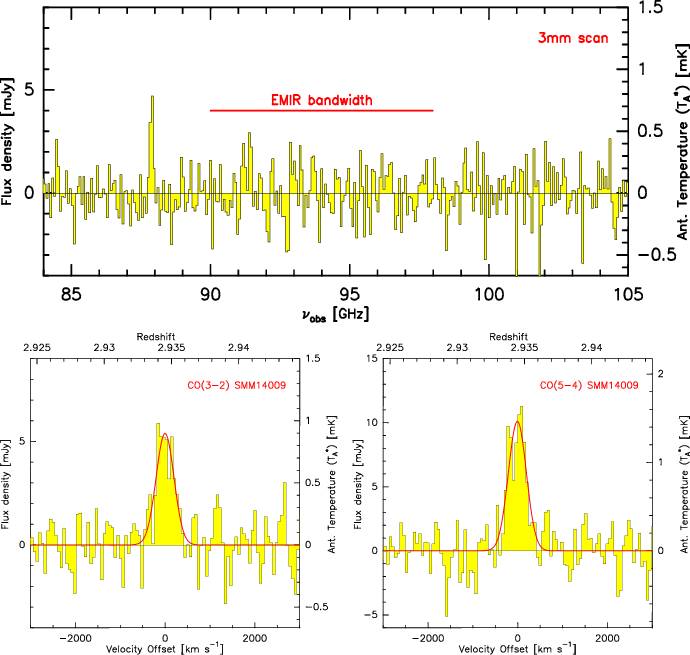
| Figure 3:
Top: EMIR 3-mm scan covering |

| Figure 3:
Top: EMIR 3-mm scan covering |
Studies of infra-red luminous galaxies at high redshift are a key element for improving our understanding of galaxy evolution in the early Universe. Sensitive blank-field mm and submm continuum surveys have discovered hundreds of these dusty, star-forming submm galaxies (SMGs) over the past decade. Progress in studying their redshift distribution, however, has been much slower, because the large dust content of SMGs means they often have only weak, if any, counterparts in the rest-frame UV and optical, making spectroscopic redshift determinations extremely difficult.
A promising alternative route to derive the redshift of SMGs is through observations of CO emission lines at mm wavelengths. These lines arise from the material feeding the star formation in SMGs and do not suffer from extinction. Detections can be related unambiguously to the submm continuum source. The narrow bandwidth of the old IRAM receivers, however, placed severe limitations on this technique as it was too time-consuming to search blindly for the CO lines in redshift space via multiple tunings of the receivers.
With the commissioning of the multi-band heterodyne receiver EMIR this situation has greatly improved. The 8-GHz instantaneous dual-polarization bandwidth of EMIR in the 3-mm band implies that a blind search for the CO lines can be done 32 times faster than with the old receiver setup at the 30m telescope. At the same time the 2MHz spectral resolution guarantees that the CO line profiles can be resolved. To demonstrate the capabilities of EMIR as a ``redshift machine'' we targeted SMMJ14009+0252 in July 2009. This source was one of the first SMGs discovered by SCUBA a decade ago but - despite several attempts - no spectroscopic redshift could be determined mainly because of its faintness at near-IR/optical wavelengths.
EMIR was used to scan ![]() GHz of bandwidth in the 3-mm window (Fig. 3 top).
The excellent performance of the receiver allowed to reach an r.m.s noise
level of
GHz of bandwidth in the 3-mm window (Fig. 3 top).
The excellent performance of the receiver allowed to reach an r.m.s noise
level of
![]() Kelvin in only 6 hours of observing time per tuning.
A 5-mJy line was clearly detected and identified as CO(3-2) through
observations of the CO(5-4) line in the 2-mm band of EMIR (Fig. 3 bottom).
These two lines unambiguously determine the redshift of SMMJ14009+0252
to
Kelvin in only 6 hours of observing time per tuning.
A 5-mJy line was clearly detected and identified as CO(3-2) through
observations of the CO(5-4) line in the 2-mm band of EMIR (Fig. 3 bottom).
These two lines unambiguously determine the redshift of SMMJ14009+0252
to
![]() .
.
This exciting result illustrates the excellent performance and sensitivity
of EMIR and opens up a new window for studying galaxy evolution over the
lifetime of the universe.